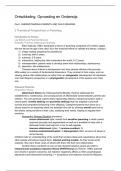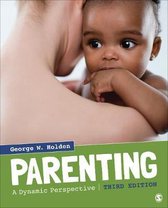Ontwikkeling, Opvoeding en Onderwijs
Part I: UNDERSTANDING PARENTS AND CHILD REARING
2 Theoretical Perspectives on Parenting
Introduction to Theory
Lay Beliefs and Parental Behavior
Scientific Theories Addressing Parenting
Ellen Galinsky (1981) developed a theory of parenting comprised of 6 orderly stages
that are tied to the age of the child: (but: few empirical efforts to validate this theory, critique)
1) image making: preparing for parenthood.
2) nurturing: birth-2 years.
3) authority: 2-5 years.
4) interpretive: helping the child understand the world; 5-12 years.
5) interdependent: parents need to develop anew their relationships; adolescence.
6) departure: late adolescence.
Theories about children’s development–and how parents influence this process–
differ widely on a variety of fundamental dimensions. They contrast in their scope, such as
viewing parent-child relationships as either from an ontogenetic (development of individuals
over their lifespan) perspective or a phylogenetic (development of the species over time)
one.
Classical Theories
Attachment Theory
Attachment theory (by child psychiatrist Bowlby; Harlow) addresses the
establishment, maintenance, and consequences of affectionate bonds between parents and
children. The core premise: parent-infant relationship reflects a behavioral system (with 2
central parts: novelty seeking and proximity seeking) that has adapted to promote
survival and competent functioning of the offspring. Caregivers/parents thus serve as a
secure base for an exploring infant and establish this role by showing warmth and love to
the infants, being sensitive to their cues, satisfying their needs, helping to regulate their
emotions.
Ainsworth’s Strange Situation procedure:
- secure attachment style: results from sensitive parenting in which parent
responds promptly and appropriately as well as is available to help calm a
distressed infant and help him or her to self-regulate.
- insecure attachment styles: 1) anxious-avoidant, 2)
anxious-resistant/ambivalent, 3) disorganized (often survivors of abuse or
some trauma).
Children build an understanding of the world that contains ideas and expectations about how
other people will behave toward them: internal working models. As their social world
expands, they carry these views of others with them into their new relationships.
Another theory centered on love (or lack thereof) between parent and child is
interpersonal acceptance-rejection theory (IPARTheory) (by Rohner, 1986): parental
love results in positive outcomes, but rejection negatively affects a child’s psychological
adjustment and behavioral functioning. (-> acceptance and rejection across the lifespan).
, Pancultural results: across (all) cultures.
Behavioral Theory
Watson’s early behavioral theory (on child development) was based on classical
conditioning (associative learning). Skinner added operant conditioning to this theory with
reinforcements (can work bidirectional or dynamic) and punishments (effective when used
consistently (when misbehavior), contingently (right after misbehavior), firmly and decisively)
making behaviors more or less likely to recur.
Biological, genetic, and environmental influences
Evolutionary Developmental Psychology
Darwin’s theory of natural selection (1859): those individuals better suited for their
environment will survive longer, are more likely to pass on their genes, and leave behind
more offspring than those individuals who are less well adapted.
Altricial human infant: an organism requiring care and feeding to survive.
Alloparenting: the provision of infant care by adults who are not biologically-related
to the child.
Evolutionary psychology views our heritage as providing a propensity or bias
toward behaving or reacting in particular ways due to selection pressures (but possible to
counteract that bias).
Behavioral Genetics Theory
Human behavioral genetics is concerned with evaluating the possibility of how
human traits and even behaviors might be directly impacted by genetic inheritance.
Behavioral genetics theory: focuses on genetic inheritance and environmental contributions
to behavior or particular characteristics. (interested in genotype as well as phenotype).
-> nativist (or maturational) theory of development (by Gesell): children’s genetic
constitution determines the natural unfolding of their inherited predispositions.
Epigenetics: the study of how phenotypic expression is affected by prior experience.
Gene-environment interaction: how genetic makeup influences development.
Genes can play a passive role (environment independent of influence of child’s genotype),
active role (direct a child to seek out certain environments), or evocative role (parents react
to a child’s phenotype in a particular way unique to that child).
Within any family, a child experiences both a shared environment (among family
members) and nonshared environment (unique to that child).
Group socialization theory (by Harris): proposes that adolescent peer influences
are the key environmental agents that mold children into the people they become.
Ecological Systems Theory
Ecological systems theory (by Bronfenbrenner): captures how the developing child
is embedded in a series of environmental systems or contexts that interact with one another
and with the child. There is a transactional influence between the person and the
environment: a person’s behavior is a function of the person and the environment.
, The Ecological systems model
Social Learning and Social Theories
Social Cognitive Theory
Social cognitive theory is a derivative from social learning theories which address
how social behavior is modified through social experiences. A key concept in Gerald
Patterson’s model of social learning (1982) is coercive cycles, problematic interactions
in which parent and child compete to see who can gain the upper hand. Parents need to
avoid getting into these cycles by carefully thinking about what issues are important enough
to have conflict over, recognize when conflict is escalating, and terminate an escalation
before the situation gets out of control.
Bandura’s social learning theory (2001) is more comprehensive regarding social
learning, in which he recognized the fundamental roles that direct learning and observational
learning play in the establishment of new behavior. Children are more likely to imitate
models whom they perceive as powerful and nurturant. This theory later developed into
social cognitive theory, in which agency (intentionally producing certain effects) is
emphasized, although it is recognized how we act is influenced by a variety of variables,
such as personal (e.g. self-efficacy) and environmental determinants.
Social Relational Theory
Parent-child relationships are shaped by both child effects and parent effects (->
bidirectional influences). Richard Bell’s Control Theory accounts for parental regulation of
child behavior. It concerns the ongoing reciprocal nature of interactions, reflecting the view
that parents and children regulate each other’s behavior, with both agents trying to keep the
other’s behavior in their upper and lower limit of tolerance for intensity. (-> narrow theory that
focuses on child effects).





